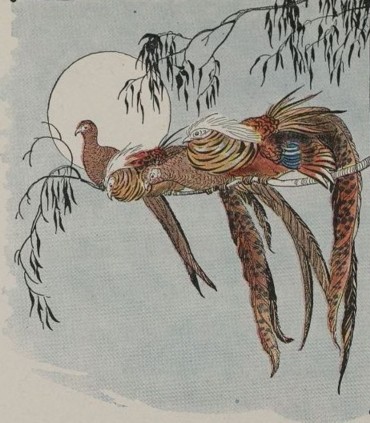PART A_1
Let’s learn vocabulary. Listen and repeat the words and the sentences with your tutor.
PART A_2
| 1. pheasant | /FEZ-uhnt/ |
| -a large bird with a rounded body and long tail, sometimes hunted as a sport and eaten as food | |
| Most pheasants are found in Asia. | |
| 2. perch | /purch/ |
| -to sit on or near the edge of something | |
| The house was perched on top of a massive rock. | |
| 3. caper | /KEY-per/ |
| -an illegal, unusual, or entertaining activity | |
| There has been a number of strange caper calls at the police station. | |
| 4. hind | /hahynd/ |
| -at the back of an animal’s body | |
| The dog stood on his hind legs, waving his front paws at the man. | |
| 5. dazed | /deyzd/ |
| -very confused and unable to think clearly | |
| I step out into the brightness of the street while slightly dazed by the encounter. |
PART B_1
Let’s read the story. Please read them aloud, and I will check your pronunciation and intonation.
PART B_2
The Fox and the Pheasants

One moonlight evening as Master Fox was taking his usual stroll in the woods, he saw a number of Pheasants perched quite out of his reach on a limb of a tall old tree. The sly Fox soon found a bright patch of moonlight, where the Pheasants could see him clearly; there he raised himself up on his hind legs, and began a wild dance. First he whirled ’round and ’round like a top, then he hopped up and down, cutting all sorts of strange capers. The Pheasants stared giddily. They hardly dared blink for fear of losing him out of their sight a single instant.
Now the Fox made as if to climb a tree, now he fell over and lay still, playing dead, and the next instant he was hopping on all fours, his back in the air, and his bushy tail shaking so that it seemed to throw out silver sparks in the moonlight.
Now the Fox made as if to climb a tree, now he fell over and lay still, playing dead, and the next instant he was hopping on all fours, his back in the air, and his bushy tail shaking so that it seemed to throw out silver sparks in the moonlight.
By this time the poor birds’ heads were in a whirl. And when the Fox began his performance all over again, so dazed did they become, that they lost their hold on the limb, and fell down one by one to the Fox.
Too much attention to danger may cause us to fall victims to it.
PART C_1
Let’s answer comprehension questions. Please answer them based on the story.
PART C_2
| 1. | Where were the Pheasants perching when the Fox saw them? |
| 2. | What was the first action the Fox did to trick the Pheasants? |
| 3. | How did the Pheasants fall into the Fox’s trap? |
PART D_1
Let’s discuss the story. Please answer the questions below and express your opinions.
PART D_2
| 1. | Do you agree with the fable’s lesson? Why or why not? |
| 2. | How would you describe the Pheasants in the story? |
| 3. | How do you keep yourself safe? |
| 4. | What do you initially do in times of danger? |
| 5. | Have you had an experience similar to the fable’s lesson? Please tell me more about it. |
REVIEW AND FEEDBACK
Now, let us review the things that you learned in this lesson.
ではこのレッスンで学んだことを振り返りましょう。
(Please give a short feedback on how your student did on your class.)
| Grammar 文法 |
Pronunciation 発音 | Vocabulary 単語 |
Comprehension 理解 |
|
|---|---|---|---|---|
 GOOD GOOD |
文法の誤りはほとんどなく、完全な文章で話すことができる | ほとんどの単語をはっきりと正しく発音することができる | 習った表現を適切に使うことができる | 文章を理解し、質問に正しく答えることができる |
 FAIR |
文法の誤りはあるが、完全な文章で話すことができる | 発音の練習が必要な言葉がいくつかある | たまにミスはあるが、習った表現を適切に使うことができる | 文章を完全に理解するのは難しく、質問に正しく答えられないときもある |
 POOR |
文章で話すのは難しく、単語だけで話すことができる | 発音の練習が必要である | 習った単語と表現を少しだけ使うことができる | 文章を理解するのは難しく、質問に答えるのは難しい |
Parts of this lesson material are based on:
An eBook from The Project Gutenberg.
This eBook is for the use of anyone anywhere at no cost and with almost no restrictions whatsoever. You may copy it, give it away or re-use it under the terms of the Project Gutenberg License included with this eBook or online at www.gutenberg.org
An eBook from The Project Gutenberg.
This eBook is for the use of anyone anywhere at no cost and with almost no restrictions whatsoever. You may copy it, give it away or re-use it under the terms of the Project Gutenberg License included with this eBook or online at www.gutenberg.org